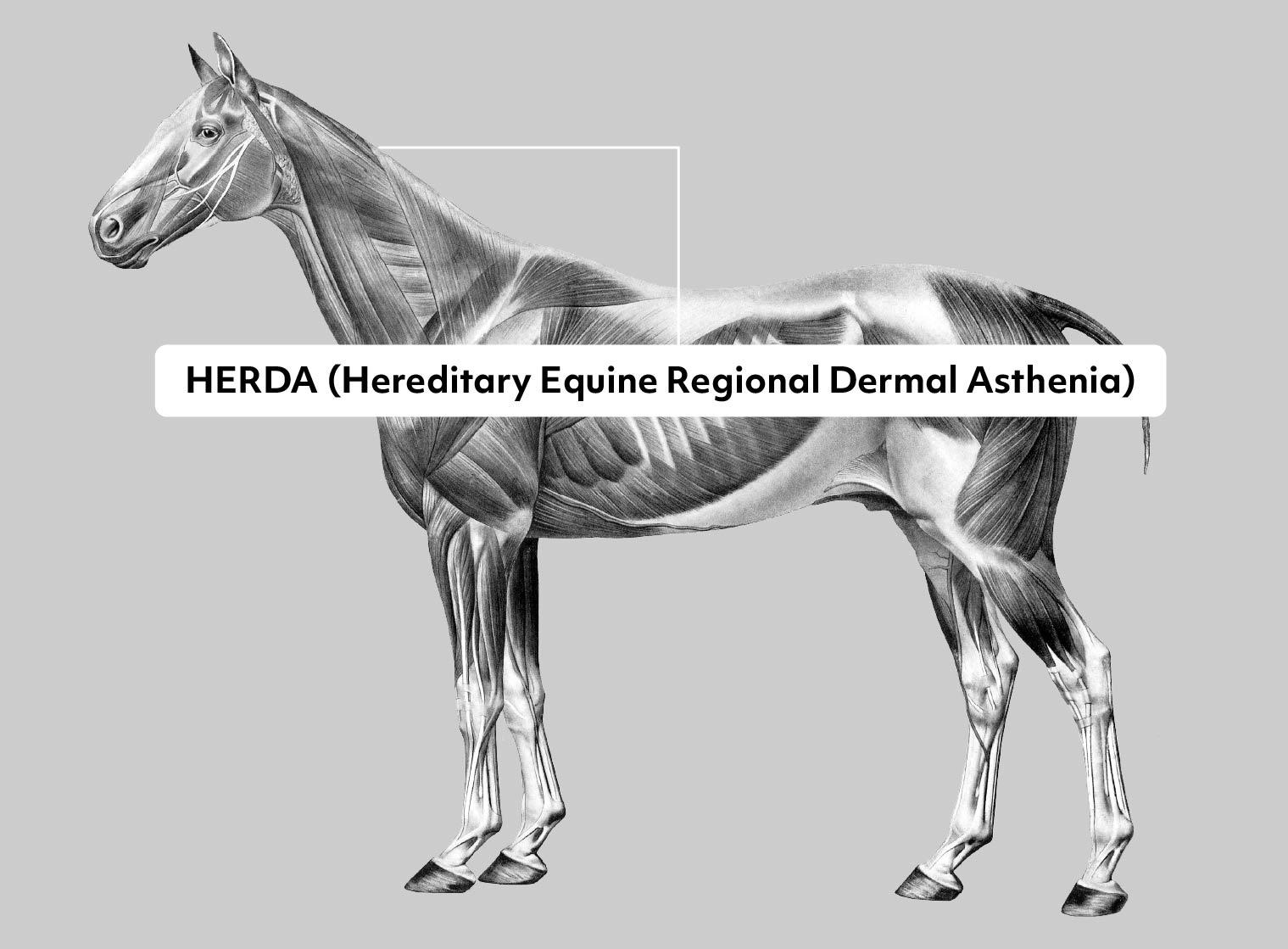Hereditary Equine Regional Dermal Asthenia (HERDA)
Gene or Region: PPIB
Reference Variant: G
Mutant Variant: A
Affected Breeds: Quarter Horse
Research Confidence: High - Findings reproduced in multiple studies
Explanation of Results: herda/herda = homozygous for Hereditary Equine Regional Dermal Asthenia, trait expressed, may result in severe/fatal health issues herda/n = heterozygous for Hereditary Equine Regional Dermal Asthenia, carrier n/n = no variant detected
General Description for Hereditary Equine Regional Dermal Asthenia (HERDA)
Hereditary Equine Regional Dermal Asthenia (HERDA) is a degenerative skin disease that primarily affects the American Quarter Horse breed. Loose skin is often an early indication of the disease, and severe seromas, hematomas, ulcerations usually develop around 1.5 years of age and progressively worsen. There is no cure, and the majority of affected animals have to be euthanized within 2-4 years.
A missense mutation in the equine cyclophilin B (PPIB) was determined to cause a functional defect in this protein, resulting in less effective catalysis of the rate-limiting step in collagen folding. Etalon offers diagnostic testing to determine carrier or affected status.
This disease follows an autosomal recessive mode of inheritance, so in order for the foal to be affected, both the sire and the dam must carry the allele. This also means that horses can appear normal but be carriers for the condition. If two carrier horses mate, there is a 25% chance that the foal will have HERDA. Studies estimate that ~3.5% of Quarter Horses are carriers. It's recommended that both carriers and clinically affected horses with HERDA be removed from breeding programs.
References
Tryon et al., “Homozygosity mapping approach identifies a missense mutation in equine cyclophilin B (PPIB) associated with HERDA in the American Quarter Horse.” (2007) Genomics 90: 93-102. PMID: 17498917
Ishikawa Y, Vranka JA, Boudko SP, Pokidysheva E, Mizuno K, Zientek K, Keene DR, Rashmir-Raven AM, Nagata K, Winand NJ, Bächinger HP. Mutation in cyclophilin B that causes hyperelastosis cutis in American Quarter Horse does not affect peptidylprolyl cis-trans isomerase activity but shows altered cyclophilin B-protein interactions and affects collagen folding. J Biol Chem. 2012 Jun 22;287(26):22253-65. doi: 10.1074/jbc.M111.333336. Epub 2012 May 3. PMID: 22556420; PMCID: PMC3381186.
More Horse Health
Equine Herpes Virus Type 1 & Induced Myeloencephalopathy
Equine herpesviruses are DNA viruses that are found in most horses all over the world, often without any serious side effects. Following infection of Equine Herpesvirus Type 1 (EHV-1) some horses then suffer Equine Herpesvirus Myeloencephalopathy (EHM), which is is accompanied by serious and sometimes fatal neurological effects. EHM in horses can have serious neurological symptoms on affected horses.
Equine Metabolic Syndrome / Laminitis Risk
Equine Metabolic Syndrome (EMS) is a wide-spread issue in the horse population. Primarily characterized by hyperinsulinemia (excess insulin circulating in the blood in relation to glucose levels), this metabolic disorder is often present in obese horses and ponies and can be challenging to diagnose as it can be misdiagnosed as "Cushing's" (a pituitary disfunction).
Equine Recurrent Uveitis Risk and Severity
Equine Recurrent Uveitis (ERU) is the most common cause of blindness in horses, affecting about 3-15% of the horse population worldwide. Characterized by episodes of inflammation of the middle layer of the eye, Equine Recurrent Uveitis in horses leads to the development of cataracts, glaucoma and eventually complete loss of vision.
